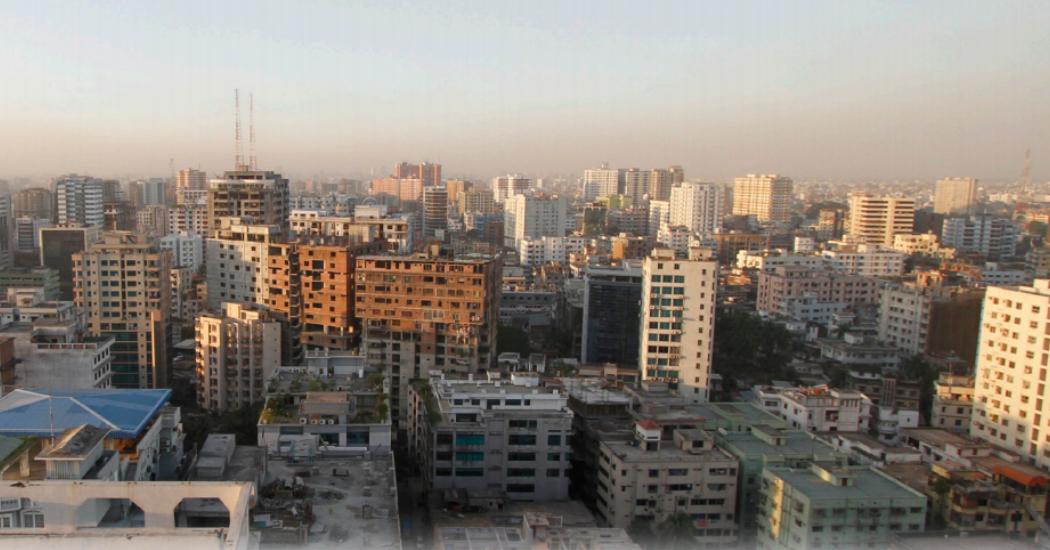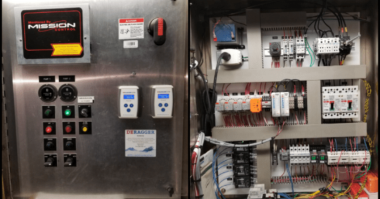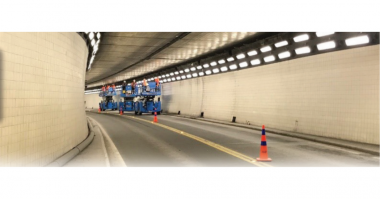Non-revenue water (NRW) is an important component water system management. NRW is usually the result of pipeline leakage, illegal service connections, water theft and meter inaccuracies.
DWASA is entrusted with supply of piped water for Dhaka Metropolitan City, DND area and Narayanganj City Corporation in the south, and Mirpur-Uttarq in the North.
As of June 2014, 75% of the city area was under DWASA water supply coverage, out of which 78% is from groundwater sources tapping through 675 deep tube wells and the remainder is supplied from two major treatment plants at Saidabad and Chadnighat and two smaller plants in Narayangan.
The population of Dhaka City is approximately 12.5 million, and the growth trends indicate by the year 2025 the population will be about 25 million.
In order to meet the growing demand, DWASA is installing high capacity water wells tapped into the Dupitalia aquifers however this aquifer is already in a stressed condition.
The present rate of depletion gives an alarming indication that there is an urgent need to alleviate pressure on the existing aquifer and explore more suitable or sustainable sources to supplement the current water supply.

Demand management is an important concept for water supplies in any large city to assist in optimizing the use of scarce water resource. In Dhaka it has been identified that it is imperative to develop an immediate, mid- and long term demand management plan to allow it to supply the needs of domestic, commercial, and industrial consumption.
NRW is a key element of the plan with approximately 55% of current water production being estimated as being NRW (2001).
Reduced levels of NRW can significantly contribute to increased levels of access for the population to safe drinking water.
Pivotal to the Demand Management Plan is Cla-Val’s advanced technology and our local partner System Engineering Ltd’s ability to supply and integrate all elements of smart valve control and SCADA installation and integration.
System Engineering Ltd formed in 2000 and is an ISO certified company with 560 staff across the country.
Their arrangement with Dhaka WASA was for the installation and commissioning of Cla-Val smart valves with centralized SCADA system with the following objectives:
- Real-time controlling of water supply
- Water Rationing between different distribution zones
- Monitoring of water budget
Project implementation stages are planned as follows:
- Planning, designing, and site surveying, and deployment of manpower.
- Project documentation and site preparation for PRV installation
- SCADA and RTU programming, configuration, and testing
- Collection of required material, local and offshore purchase
- Civil and mechanical works for PRV at site
- Final commissioning, testing, and site handover
Completed works so far are supply and installation of 34 sets of 250, 300mm, and 500mm 3690 series pressure control valves with CRD34 motorized pilots, X144 flow meters, X143IP series turbines.

So the implementation phases are:
Phase One
- Procurement
- RTU and server preparation
- Server System Configuration
- Permitting
Phase Two
- Permitting
- Site preparation
- Installation of Smart PRV’s
- Commissioning
Phase Three
- Improvement analysis
- Training
- Monitoring and feedback
System Architecture
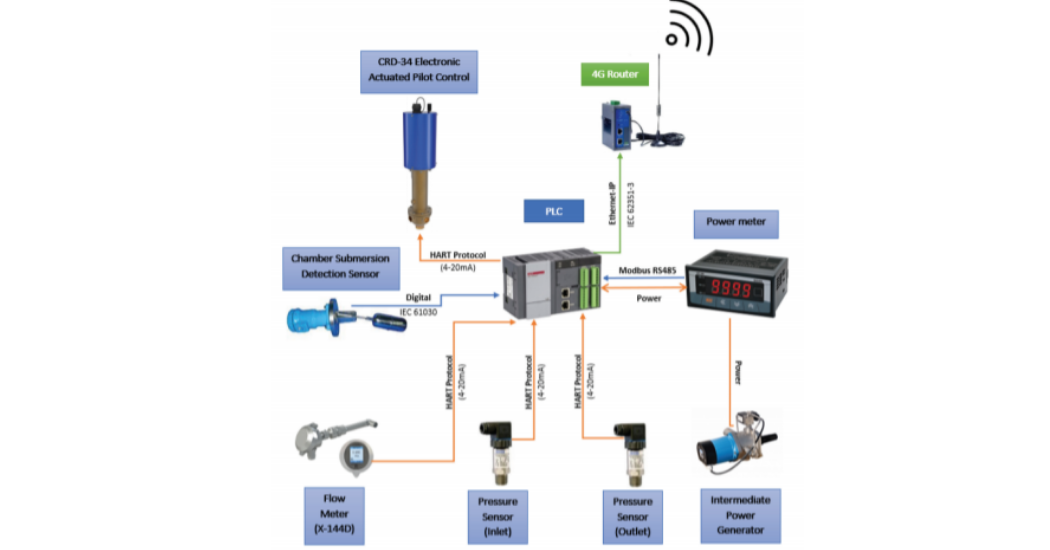
Network Topology of Web SCADA
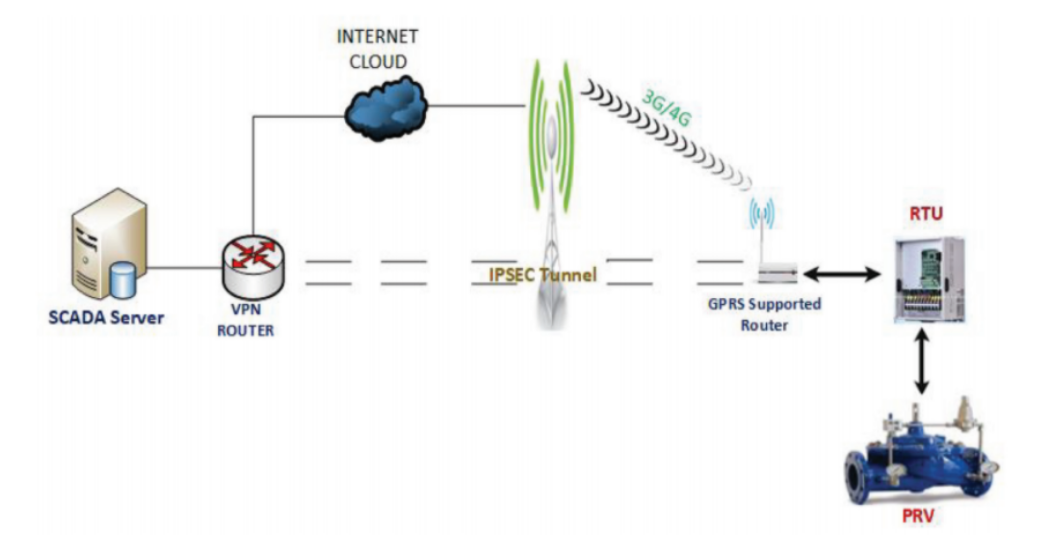
e-PRV Nodes SCADA features
Automatic Operation
- Remotely change valve setpoint
- Dynamically set valve opening in ratio to other valves
- Automatic reception of alarms
Performance Monitoring
- Real-time flow rate and total flow (daily/monthly) from SCADA
- Real-time inlet and outlet pressures
- Realtime chamber water level
- Realtime power generation from turbine
Alarms
- Low inlet and outlet pressure
- Low flow
- Low turbine output voltage
- Low battery voltage
Reporting and MIS features – SCADA
Auto Report Generation
- Automatic monthly, weekly, daily, or hourly report generation
- Auto-generated reports 14 vital e-PRV node information
- Automatic mailing of a daily report to key personnel
Logging database
- Automatic logging of 22 vital data points at each station
- All data logged by event and at one minute intervals
- Using Microsoft SQL server for data security
- Logging database is synchronized with back-up server for data security
Event logging
- All key events, alarms and warnings are logged onto the database
- Any event or alarm can be investigated from event logging
- All key data is logged at site on controller SD card
This project shows how the use of the latest technology, in conjunction with a strong local partner, can develop positive savings in water loss and pipe break frequency. The keys are selecting a strong local partner and a manufacturer who can deliver the very latest in terms of technology.
Read another Cla-Val case study!

